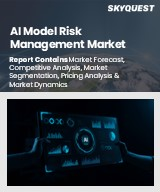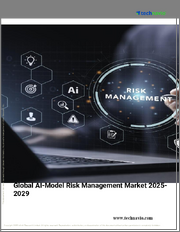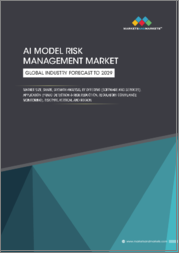
|
시장보고서
상품코드
1536768
AI 모델 리스크 관리 시장 평가 : 오퍼링별, 도입 모드별, 리스크 유형별, 용도별, 최종사용자별, 지역별, 기회, 예측(2017-2031년)AI Model Risk Management Market Assessment, By Offering, By Deployment Mode, By Risk Type, By Application, By End-users, By Region, Opportunities and Forecast, 2017-2031F |
||||||
세계의 AI 모델 리스크 관리 시장 규모는 예측 기간인 2024-2031년 CAGR이 12.70%에 달하며, 2023년 49억 8,000만 달러에서 2031년에는 129억 6,000만 달러로 성장할 것으로 예측됩니다. 시장은 크게 성장하며, 앞으로도 확대가 전망됩니다.
AI 모델 리스크 관리는 전 세계 규제 당국이 견고하고 신뢰할 수 있는 프레임워크에 주목하면서 전 세계에서 활발하게 진행되고 있습니다. 미국의 2024년 연방 인공지능 위험 관리법은 연방 정부 기관이 국립표준기술연구소(NIST)의 AI 위험 관리 프레임워크를 사용하고, 그 시행에 따른 투명성을 강화하도록 요구하고 있습니다. 유럽이 제안한 AI 법안은 윤리적 인공지능의 신뢰할 수 있는 배포를 위해 위험에 기반한 분류를 사용하고 있습니다. 일본의 AI 전략은 AI 시스템 운영의 투명성과 책임성을 확보하는 것을 목표로 하고 있습니다. 표준화 노력은 미국 국립표준기술연구소(NIST)와 유럽 AI 얼라이언스(European AI Alliance)와 같은 주요 단체가 주도하고 있습니다. 이러한 규제와 가이드라인은 전 세계에서 AI 기술의 위험 감소와 신뢰 구축에 필요한 점점 더 엄격한 기준을 충족시키기 위해 조직들이 노력하고 있으며, 이는 시장 성장에 기여하고 있습니다.
미국 연방거래위원회(FTC)에 따르면 AI 모델 리스크 관리는 AI의 편향성을 해결해야 합니다. 지난해 소비자들은 디지털 결제 채널을 이용한 사기꾼으로 인해 약 88억 달러의 손실을 입었으며, 이 수치는 AI의 편향은 불공정한 결과, 법적 문제, 소비자 이탈을 초래할 수 있으므로 더욱 엄격한 AI 규제의 시급성을 강조하고 있습니다. 이를 고려하여 기업은 AI 위험 관리 프레임워크를 채택하고, 이러한 편향성을 표적으로 삼고 모니터링함으로써 AI의 윤리적 사용에 대한 규칙을 시행하고 있습니다. 그 결과, 투명성과 규제 준수를 향상시키면서 편향성을 감지하고 완화할 수 있는 솔루션에 대한 기업의 품격이 높아지면서 시장 수요가 증가하고 있습니다. 기업은 AI를 사용하여 모든 활동과 관련된 데이터를 분석하여 안전한 온라인 습관을 만들 수 있습니다.
사이버 보안 위협 증가로 인해 AI 모델 리스크 관리 시장 수요가 급증하고 있습니다. Global Risks Report 2024에 따르면 전문가의 39%가 사이버 공격을 5대 리스크 중 하나로 꼽았으며, 2024년에는 사이버 공격이 업계 위기를 초래할 가능성이 높다고 응답했습니다. 높습니다. 이러한 우려는 AI 기반 위험 관리 솔루션으로 대체되고 있으며, 이를 통해 조직은 보안 관행을 개선하고 위험에 처하기 전에 위협을 식별할 수 있습니다. 인공지능은 취약점을 예측할 수 있으므로 기업은 침해가 발생하기 전에 스스로를 보호하고 엄격한 규제 표준을 준수할 수 있습니다.
세계의 AI 모델 리스크 관리 시장에 대해 조사했으며, 시장의 개요와 오퍼링별, 도입 모드별, 리스크 유형별, 용도별, 최종사용자별, 지역별 동향 및 시장에 참여하는 기업의 개요 등을 제공하고 있습니다.
목차
제1장 프로젝트의 범위와 정의
제2장 조사 방법
제3장 개요
제4장 고객의 소리
제5장 세계의 AI 모델 리스크 관리 시장 전망, 2017-2031년
- 시장 규모 분석과 예측
- 시장 점유율 분석과 예측
- 시장 맵 분석, 2023년
- 오퍼링별
- 도입 모드별
- 리스크 유형별
- 용도별
- 최종사용자별
- 지역별
제6장 북미의 AI 모델 리스크 관리 시장 전망, 2017-2031년
제7장 유럽의 AI 모델 리스크 관리 시장 전망, 2017-2031년
제8장 아시아태평양의 AI 모델 리스크 관리 시장 전망, 2017-2031년
제9장 남미의 AI 모델 리스크 관리 시장 전망, 2017-2031년
제10장 중동 및 아프리카의 AI 모델 리스크 관리 시장 전망, 2017-2031년
제11장 밸류체인 분석
제12장 Porter's Five Forces 분석
제13장 PESTLE 분석
제14장 시장 역학
제15장 시장의 동향과 발전
제16장 사례 연구
제17장 경쟁 구도
- 시장 리더 상위 5사의 경쟁 매트릭스
- 상위 5사 SWOT 분석
- 주요 기업 상위 10사의 상황
- Alphabet inc.
- Amazon Web Services, Inc.
- Fair Isaac Corporation
- IBM Corp.
- Microsoft Corp.
- Moody's Analytics, Inc.
- Oracle Corporation
- Palantir Technologies Inc.
- Riskified, Inc.
- SAS Institute Inc.
제18장 전략적 제안
제19장 문의와 면책사항
KSA 24.08.30Global AI model risk management market is projected to witness a CAGR of 12.70% during the forecast period 2024-2031, growing from USD 4.98 billion in 2023 to USD 12.96 billion in 2031. The market has grown significantly and is set for continued expansion.
AI Model Risk Management is on a global rise as regulators across the globe look at solid and reliable frameworks. The United States Federal Artificial Intelligence Risk Management Act of 2024 requires federal agencies to use the National Institute of Standards and Technology (NIST) AI Risk Management Framework to enhance transparency with implementation. The AI act proposed by Europe uses risk-based classification to enable trustworthy deployment of ethical artificial intelligence. Japan's AI strategy seeks to ensure transparency and accountability in the operation of AI systems. Standardization efforts are led by key associations such as National Institute of Standards and Technology (NIST), and the European AI Alliance. Together, these regulations and guidelines contribute to market growth as organizations aim to meet increasingly stringent standards that are necessary for risk reduction and trust-building in AI technologies around the world.
For instance, in June 2023, the European Union's AI Act, the world's first comprehensive AI regulation, sets strict rules on high-risk AI applications, ensuring safety and transparency, while banning harmful uses and fostering innovation.
Mitigation of AI Bias to Fuel AI Model Risk Management Market
AI model risk management needs to tackle AI bias in accordance with the Federal Trade Commission (FTC). Consumers lost nearly USD 8.8 billion to scammers taking advantage of digital payment channels last year, the figure highlights an urgency for more rigorous AI regulation. AI bias can cause unjust results, legal issues, and consumer abandonments. Considering this, companies are increasingly adopting AI risk management frameworks to target and monitor these biases thereby enforcing the rules for ethical usage of AI. This has in-turn driven the market demand, as dignity organizations look for solutions that can detect and mitigate biases while delivering better transparency and compliance with regulations. Businesses can use AI to analyze data related to every activity, creating secure online habitats which lead the way for trust and innovation in a society that has little room for human error, when it comes to compliance of consumers and regulatory needs.
For instance, in May 2024, IBM Corp. unveiled major updates to its watsonx platform, including open-sourced Granite models and InstructLab, alongside strengthened partnerships with major tech firms to drive enterprise AI innovation.
Rising Cybersecurity Concerns Drive the AI Model Risk Management Market Growth
The AI model risk management market need has soared due to rising cybersecurity threats. Able to implement more evasive tactics, cyberattacks have led enterprises towards identity theft and financial loss. According to the Global Risks Report 2024, 39% of experts observe cyberattacks as one of top-five risks, likely triggering an industry crisis in 2024. This concern is giving way to AI-powered risk management solutions, allowing organizations to improve security practices and identify threats before they become hazardous. Artificial intelligence can predict vulnerabilities, hence companies are able to protect themselves before a breach occurs and comply with strict regulatory standards.
For instance, in April 2024, Oracle Corporation introduced its AI-powered Financial Services Compliance Agent to enhance banks' anti-money laundering efforts. The service offers cost-effective scenario testing and improved risk assessment capabilities.
Government Initiatives Acting as a Market Catalyst
Global government efforts are propelling AI model risk management market across the world. Strong security and transparency requirements of the European Union Artificial Intelligence Act will create new market opportunities for risk management solutions. The United Kingdom National AI Strategy, for instance, is disproportionately concerned with cybersecurity and subsequently prioritizes investment in AI risk management solutions. Cybersecurity and the ethical use of AI have been given importance in India's National AI Portal, as well is Singapore's AI Governance Framework where research and development for advanced risk management tools should be used. The AI Action Plan of Australia and the Pan-Canadian AI Strategy support use cases for cybersecurity in enhancing performance through AI capabilities, propelling the market revenue. These controls and techniques allow companies to build a full AI risk management platform.
For instance, in January 2023, NIST launched the AI Risk Management Framework (AI RMF 1.0), fulfilling a mandate from the National AI Initiative Act of 2020. This voluntary framework offers guidance for managing AI risks, promoting trust and accountability.
BFSI Sector Leading in AI Model Risk Management Market
BFSI is at a forefront in the AI model risk management market as it uses advanced technologies for complex problems in an age where cyber threats are accelerating and regulations tightening, banks want AI powered by machine learning to manage risk better. Artificial Intelligence analyzes huge data and makes important things such as credit risk assessment, fraud detection, and regulatory compliance which is super easy to do in real-time. This proactive alternative replaces the conventional measures of reacting to the market and provides substantial operational resilience. Incorporating AI/ML tools into compliance processes accelerates financial institutions, making them pioneers of risk management innovation by improving process efficiency and security.
North America Dominates AI Model Risk Management Market Share
North America dominates the AI model risk management market due to its advanced technological infrastructure and large-scale investments made by the government. Efforts to adopt AI have been quite high in the United States and Canada, where very minimal regulations or government policies are used as launchpads by innovators into how they want to apply the learnings above output representation networks for ideas such as Targeted Learning Machines. Other recent initiatives include the Federal Infrastructure Modernization Act, which strengthens cyber defenses while issuing guidance on how to prioritize AI technologies under FedRAMP.
For instance, in June 2023, Moody's Analytics, Inc. and Microsoft Corp. announced a strategic partnership to develop advanced risk, data, and analytics solutions using Microsoft's Azure OpenAI Service and Moody's proprietary data.
Future Market Scenario (2024 - 2031F)
Governments worldwide will introduce stricter regulations, requiring more rigorous oversight and compliance measures for AI models, boosting the demand for advanced risk management solutions.
The need for robust risk management strategies will surge, driving innovation and market growth as industries integrate AI models across various applications.
Organizations will prioritize sophisticated risk management frameworks to safeguard data integrity and system security with rising cyber threats targeting AI systems.
AI models will evolve to offer more accurate risk predictions and proactive mitigation strategies, transforming how businesses manage and respond to potential threats.
Key Players Landscape and Outlook
Prominent players in the AI model risk management market are developing sophisticated models that can automatically identify and correct errors. Alphabet Inc. and Microsoft corp. deploy their cloud infrastructure with AI skills, as IBM Corp. and Oracle Corporation are offering a few of the most difficult competition from long standing analytics subsidiaries. Moody's Analytics, Inc. specializes in financial analytics and AWS builds scalable cloud services.
In July 2024, Moody's Analytics, Inc. launched a GenAI-powered Early Warning System for commercial real estate, offering real-time alerts and risk assessments to enhance portfolio management.
Table of Contents
1. Project Scope and Definitions
2. Research Methodology
3. Executive Summary
4. Voice of Customer
- 4.1. Product and Market Intelligence
- 4.2. Mode of Brand Awareness
- 4.3. Factors Considered in Purchase Decisions
- 4.3.1. Features and Other Value-Added Service
- 4.3.2. IT Infrastructure Compatibility
- 4.3.3. Efficiency of Solutions
- 4.3.4. After-Sales Support
- 4.4. Consideration of Privacy and Regulations
5. Global AI Model Risk Management Market Outlook, 2017-2031F
- 5.1. Market Size Analysis & Forecast
- 5.1.1. By Value
- 5.2. Market Share Analysis & Forecast
- 5.2.1. By Offering
- 5.2.1.1. Software
- 5.2.1.2. Services
- 5.2.2. By Deployment Mode
- 5.2.2.1. On-premises
- 5.2.2.2. Cloud-based
- 5.2.3. By Risk Type
- 5.2.3.1. Security Risk
- 5.2.3.2. Ethical Risk
- 5.2.3.3. Operational Risk
- 5.2.4. By Application
- 5.2.4.1. Fraud Detection and Prevention
- 5.2.4.2. Credit Scoring and Assessment
- 5.2.4.3. Market Risk Analysis
- 5.2.4.4. Anti-Money Laundering (AML) Compliance
- 5.2.4.5. Cybersecurity Threat Detection
- 5.2.4.6. Supply Chain Risk Prediction
- 5.2.4.7. Others
- 5.2.5. By End-users
- 5.2.5.1. Banking, Financial Services and Insurance (BFSI)
- 5.2.5.2. Retail and E-commerce
- 5.2.5.3. IT and Telecom
- 5.2.5.4. Manufacturing
- 5.2.5.5. Healthcare
- 5.2.5.6. Media and Entertainment
- 5.2.5.7. Government and Public Sector
- 5.2.5.8. Others
- 5.2.6. By Region
- 5.2.6.1. North America
- 5.2.6.2. Europe
- 5.2.6.3. Asia-Pacific
- 5.2.6.4. South America
- 5.2.6.5. Middle East and Africa
- 5.2.7. By Company Market Share Analysis (Top 5 Companies and Others - By Value, 2023)
- 5.2.1. By Offering
- 5.3. Market Map Analysis, 2023
- 5.3.1. By Offering
- 5.3.2. By Deployment Mode
- 5.3.3. By Risk Type
- 5.3.4. By Application
- 5.3.5. By End-users
- 5.3.6. By Region
6. North America AI Model Risk Management Market Outlook, 2017-2031F*
- 6.1. Market Size Analysis & Forecast
- 6.1.1. By Value
- 6.2. Market Share Analysis & Forecast
- 6.2.1. By Component
- 6.2.2. By Offering
- 6.2.2.1. Software
- 6.2.2.2. Services
- 6.2.3. By Deployment Mode
- 6.2.3.1. On-premises
- 6.2.3.2. Cloud-based
- 6.2.4. By Risk Type
- 6.2.4.1. Security Risk
- 6.2.4.2. Ethical Risk
- 6.2.4.3. Operational Risk
- 6.2.5. By Application
- 6.2.5.1. Fraud Detection and Prevention
- 6.2.5.2. Credit Scoring and Assessment
- 6.2.5.3. Market Risk Analysis
- 6.2.5.4. Anti-Money Laundering (AML) Compliance
- 6.2.5.5. Cybersecurity Threat Detection
- 6.2.5.6. Supply Chain Risk Prediction
- 6.2.5.7. Others
- 6.2.6. By End-users
- 6.2.6.1. Banking, Financial Services and Insurance (BFSI)
- 6.2.6.2. Retail and E-commerce
- 6.2.6.3. IT and Telecom
- 6.2.6.4. Manufacturing
- 6.2.6.5. Healthcare
- 6.2.6.6. Media and Entertainment
- 6.2.6.7. Government and Public Sector
- 6.2.6.8. Others
- 6.2.7. By Country Share
- 6.2.7.1. United States
- 6.2.7.2. Canada
- 6.2.7.3. Mexico
- 6.3. Country Market Assessment
- 6.3.1. United States AI Model Risk Management Market Outlook, 2017-2031F*
- 6.3.1.1. Market Size Analysis & Forecast
- 6.3.1.1.1. By Value
- 6.3.1.2. Market Share Analysis & Forecast
- 6.3.1.2.1. By Offering
- 6.3.1.2.1.1. Software
- 6.3.1.2.1.2. Services
- 6.3.1.2.2. By Deployment Mode
- 6.3.1.2.2.1. On-premises
- 6.3.1.2.2.2. Cloud-based
- 6.3.1.2.3. By Risk Type
- 6.3.1.2.3.1. Security Risk
- 6.3.1.2.3.2. Ethical Risk
- 6.3.1.2.3.3. Operational Risk
- 6.3.1.2.4. By Application
- 6.3.1.2.4.1. Fraud Detection and Prevention
- 6.3.1.2.4.2. Credit Scoring and Assessment
- 6.3.1.2.4.3. Market Risk Analysis
- 6.3.1.2.4.4. Anti-Money Laundering (AML) Compliance
- 6.3.1.2.4.5. Cybersecurity Threat Detection
- 6.3.1.2.4.6. Supply Chain Risk Prediction
- 6.3.1.2.4.7. Others
- 6.3.1.2.5. By End-users
- 6.3.1.2.5.1. Banking, Financial Services and Insurance (BFSI)
- 6.3.1.2.5.2. Retail and E-commerce
- 6.3.1.2.5.3. IT and Telecom
- 6.3.1.2.5.4. Manufacturing
- 6.3.1.2.5.5. Healthcare
- 6.3.1.2.5.6. Media and Entertainment
- 6.3.1.2.5.7. Government and Public Sector
- 6.3.1.2.5.8. Others
- 6.3.1.2.1. By Offering
- 6.3.1.1. Market Size Analysis & Forecast
- 6.3.2. Canada
- 6.3.3. Mexico
- 6.3.1. United States AI Model Risk Management Market Outlook, 2017-2031F*
All segments will be provided for all regions and countries covered
7. Europe AI Model Risk Management Market Outlook, 2017-2031F
- 7.1. Germany
- 7.2. France
- 7.3. Italy
- 7.4. United Kingdom
- 7.5. Russia
- 7.6. Netherlands
- 7.7. Spain
- 7.8. Turkey
- 7.9. Poland
8. Asia-Pacific AI Model Risk Management Market Outlook, 2017-2031F
- 8.1. India
- 8.2. China
- 8.3. Japan
- 8.4. Australia
- 8.5. Vietnam
- 8.6. South Korea
- 8.7. Indonesia
- 8.8. Philippines
9. South America AI Model Risk Management Market Outlook, 2017-2031F
- 9.1. Brazil
- 9.2. Argentina
10. Middle East and Africa AI Model Risk Management Market Outlook, 2017-2031F
- 10.1. Saudi Arabia
- 10.2. UAE
- 10.3. South Africa
11. Value Chain Analysis
12. Porter's Five Forces Analysis
13. PESTLE Analysis
14. Market Dynamics
- 14.1. Market Drivers
- 14.2. Market Challenges
15. Market Trends and Developments
16. Case Studies
17. Competitive Landscape
- 17.1. Competition Matrix of Top 5 Market Leaders
- 17.2. SWOT Analysis for Top 5 Players
- 17.3. Key Players Landscape for Top 10 Market Players
- 17.3.1. Alphabet inc.
- 17.3.1.1. Company Details
- 17.3.1.2. Key Management Personnel
- 17.3.1.3. Products and Services
- 17.3.1.4. Financials (As Reported)
- 17.3.1.5. Key Market Focus and Geographical Presence
- 17.3.1.6. Recent Developments/Collaborations/Partnerships/Mergers and Acquisition
- 17.3.2. Amazon Web Services, Inc.
- 17.3.3. Fair Isaac Corporation
- 17.3.4. IBM Corp.
- 17.3.5. Microsoft Corp.
- 17.3.6. Moody's Analytics, Inc.
- 17.3.7. Oracle Corporation
- 17.3.8. Palantir Technologies Inc.
- 17.3.9. Riskified, Inc.
- 17.3.10. SAS Institute Inc.
- 17.3.1. Alphabet inc.
Companies mentioned above DO NOT hold any order as per market share and can be changed as per information available during research work.


















